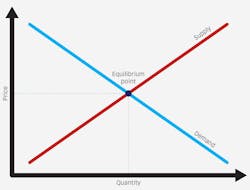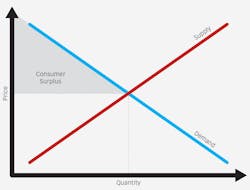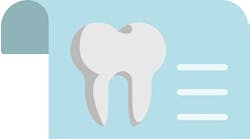Bill Layman, DMD, MBA
In my last article, we discussed the customer value equation. There are many ways to determine value in a relationship, but we are discussing the business of dentistry, and the common trade system is financial compensation for services. This article will take a look at pricing and attempt to give you some tools to use when evaluating or setting prices for your offerings.
Supply and demand
Price is the exchange rate agreed upon by the provider and patient based on the value the practitioner feels he or she is providing and the value the patient feels he or she is receiving. Prices are traditionally set by the provider in a way that helps maximize the quantity of procedures, thereby maximizing total profit under the systems created by the practice. A price is set, and the quantity of cases it creates follows the simple law of supply and demand. A supply and demand plot is oriented with price plotted along the y-axis and quantity of services/goods along the x-axis. Curves can be generated on the supply side and demand side for each industry and sector of industry.
The supply curve is an ascending curve or line from left to right and the demand curve or line descends from left to right. This phenomenon occurs because as price increases on the y-axis, the quantity demand decreases on the x-axis, and vice versa. These two lines create an equilibrium point where they intersect. This intersection defines the perfect market equilibrium. When you can achieve market equilibrium pricing, you will have a clinic that is scheduled with no wasted space, and you are maximizing the return on your invested assets of staff and equipment. See Figure 1 for graphical representation.
What do patients consider when they are exposed to a price? It is important to view these metrics in a patient’s mindset. This outside-in approach will help improve your honesty about the offering and help remove the bias you have toward your own product. Patients are not only evaluating the actual product delivered but they are also considering many other factors. How does the process feel as the patient is scheduled for the appointment all the way through to delivery of the finished product? How does the patient feel during the procedure? How the patient feels includes pain but will also include how he or she was cared for and listened to during the process.
The final product piece for our patients is how long the finished product is expected to last once completed. This was defined as perceived total lifecycle costs in our customer value equation in the last article (figure 2).
Figure 2: Customer value equation
Customer value = (1 - perceived risk)
[perceived customer benefit - perceived total lifecycle costs]
What can you do to improve the perception that your products are built to last? We may be excellent technicians, but patients are factoring in many more items than the actual product when evaluating the pricing you have proposed. Pricing is typically determined by one or a combination of these four ways in dentistry:
• Competitive pricing: Evaluating marketplace pricing and making a decision on where you want to fit into this data-driven approach
• Cost plus pricing: Identifying your input costs for a procedure and then pricing the procedure based on how much profit margin you are hoping to garner
• Price bundling: Instead of pricing all the pieces of a procedure individually, set one price to reduce hassle and ability for negotiation of many pieces
• Penetration pricing: Setting a price low to enter a competitive market or increase market share and then raising the price once established
The pricing model you choose should take into account these five factors for your practice: Does the price create the contribution margins needed to sustain and grow your lifestyle as you see fit? Can you still make investments in your practice growth? Will the price allow profits that fit into your debt reduction strategy? Is the price right to create enough business to have healthy profit margins to fully realize the first three items listed?
And lastly, are you leaving too much consumer surplus in the marketplace that could be realized by your practice? Consumer surplus is a concept derived from a supply and demand curve (figure 3). For example, if you are willing to pay $100 for a service or product and the company is charging $80 for this same item, the $20 would be considered the consumer surplus because you feel like you are receiving a good at less than you were willing to pay. The company on the other hand realizes that more people will be enticed at the $80 mark, so the increased volume creates more profit for them over the long run.
Putting it into practice
How do I apply the knowledge of these four pricing strategies and five pricing factors? Start by choosing three of your most popular items for which you are wanting to check your pricing strategy. Perform an analysis of the four pricing types above by applying the strategy to each item.
For example, the most common strategies are cost plus and competitor based. With the cost plus pricing model, offices will determine crown overhead is $500, assign another $500 to fixed costs, and another $500 for working profit, giving a final crown price of $1,500. The competitive pricing model uses a database provided by a national source that lets you know the percentile of cost in your area. If you pick the 80th percentile for your pricing, then you would land on that price. There is not one strategy that works in all markets but the strategies can be used to help you frame your decision.
Use the five pricing factors to help you determine which price strategy will work best for your practice type and practice geography to accomplish your goals. The factors are applied as a check and balance on the pricing model. Your office may like to use competitive pricing at the 50th percentile to try to attract more patients, but that model does not fit with the type of practice you are ultimately wanting to grow. Understanding the competing pressures on patient flow and practice type by using these models and factors gives you a framework to make decisions on pricing your services more proactively to accomplish your goals.
Recommendations for controlling costs
Sometimes markets create severe downward pricing pressures and you will lose autonomy over the pricing decision. To remain competitive when downward pricing pressures are being applied in your market, you must find ways to control your costs and increase your profit margins.
Consumables costs: Bidding exercises with vendors can be helpful to reduce your consumables costs. You must have a working spreadsheet of all the SKUs (items) it takes to run your practice for this strategy to be effective. We have a list of items that are not negotiable and a list of items that we review as a team each calendar year starting in September.
Employee efficiency analysis: Take the time to look for and improve inefficiencies in clinical operations. Use timed analysis of procedures and create a baseline by which you can evaluate workflows and look for improvements that reduce the use of your most valuable asset, chair time.
Doctor efficiency analysis: Are you trained in the best practices for procedures that you are performing? Doing something in less time does not always mean it is of lower quality. The amount of time a procedure takes and the quality created are not perfectly correlated. Time yourself and benchmark that against improvements that may be made through technology investment or educational investment.
Labs: When it comes to evaluating your relationship with lab services, the best practice is to evaluate what you are really paying for. A cheap crown in the short run may not be that cheap in the long run.
Conclusion
Pricing in dentistry is a complex process that includes third-party entities and autonomous players setting prices in the same marketplace. This article does not attempt to fully answer all the questions you may have but hopefully gives you some tools to start organizing frameworks in your office to evaluate current practices and adjust as you see fit.
Bill Layman, DMD, MBA, attended dental school at the Medical University of South Carolina and was an orthodontic resident at Vanderbilt University. After starting a paperless, digital orthodontic office in 2004, he completed a master of business administration degree at the Wharton School at the University of Pennsylvania. He devotes his efforts to developing full digital workflows that eliminate the need for impressions, reduce reliance on outside aligner companies, and are able to direct print orthotic dental splints.









